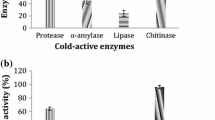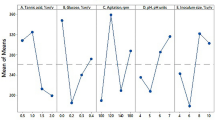Abstract
In this study, a hidden pitfall in the production of commercial tryptose soya agar (TSA) media sterilized with cobalt 60 irradiation was identified, and the applicability of TSA media was also determined. In addition, a strain of Bacillus firmus (B. firmus) with a high catalase activity, named GL3, was screened, and the conditions affecting the activity of its catalase were optimized. The 5 kinds of irradiated TSA media, named A, B, C, D, and E, were stored for 0 days, 15 days, 30 days, and 45 days, and their growth promoting ability, inhibitory properties, and sterility were analyzed to guarantee their suitability. The irradiated TSA media C had abnormal colony counts when Staphylococcus aureus (S. aureus) ATCC 6538 and Bacillus ginsengihumi (B. ginsengihumi) were used as the inocula, and both bacteria resumed normal growth when the media were stored for 15 days or the catalase was added. Screening of the significant variables and optimization of the catalase activity was performed using a Plackett–Burman design (PBD) and response surface methodology (RSM). The GL3 exhibited high catalase activity and stable catalase properties at 20–60° and pH 7.0–10.0. Under optimal conditions, the activity of catalase reached 20,668 U/mL. The abnormal counts of plates can be eliminated by increasing the storage days of the irradiated media during the effective period or by adding optimal fermentation liquid from B. firmus GL3. The high catalase activity and stable enzymatic properties of B. firmus GL3 have potential uses in industrial food applications.








Similar content being viewed by others
References
Șindilar E, Bondoc I (1996) Food poisoning caused by Bacillus cereus. Universitatea Agronomică și de Medicină Veterinară "Ion Ionescu de la Brad" Iași, Lucrări Științifice, 38–39, 125–130 (Source CAB Direct—https://www.cabdirect.org/cabdirect/abstract/19982204481?q=(Bondoc%2c+I.)
H. Zhang, Y. Zhang, Y. Lin, T. Liang, Z. Chen, J. Li, Z. Yue, J. Lv, Q. Jiang, C. Yi, Ultrasensitive detection and rapid identification of multiple foodborne pathogens with the naked eyes. Biosens. Bioelectron. 71, 186–193 (2015). https://doi.org/10.1016/j.bios.2015.04.034
Bondoc I, Șindilar EV (2002) Veterinary sanitary control of food quality and hygiene. Vol. I. "Ion Ionescu de la Brad" Iaşi Publishing, ISBN 973-8014-64-6, pp. 244–262 (Source Google Academic—https://scholar.google.ro/citations?user=-dUf6oYAAAAJ&hl=ro&oi=sra.)
K. Houf, R. Stephan, Isolation and characterization of the emerging foodborn pathogen Arcobacter from human stool. J. Microbiol. Methods 68(2), 408–413 (2007). https://doi.org/10.1016/j.mimet.2006.09.020
S. Hameed, L. Xie, Y. Ying, Conventional and emerging detection techniques for pathogenic bacteria in food science: a review. Trends Food Sci. Technol. 81, 61–73 (2018). https://doi.org/10.1016/j.tifs.2018.05.020
Bondoc I (2007) Technology and quality control of milk and dairy products. Vol. I. "Ion Ionescu de la Brad" Iaşi Publishing, ISBN 978-973-7921-97-0, pp. 29–48 (Source Google Academic—https://scholar.google.ro/citations?user=-dUf6oYAAAAJ&hl=ro&oi=sra.)
M. Trsan, K. Seme, S. Srcic, The environmental monitoring in hospital pharmacy cleanroom and microbiota catalogue preparation. Saudi Pharm. J. 27(4), 455–462 (2019). https://doi.org/10.1016/j.jsps.2019.01.007
M.C. Campagna, M.T. Di Schiavi, M. Foti, M.C. Mosconi, G. Mattiolo, R. Cavallina, Application of microbiological method direct epifluorescence filter techique/aerobic plate count agar in the identification of irradiated herbs and spices. Italian J. Food Saf. 3(3), 1650 (2014). https://doi.org/10.4081/ijfs.2014.1650
L. Ounalli, A. Mejri, N. Mejri, Radiation efficiency of a depleted cobalt-60 source for products that require low radiation doses. Radiat. Phys. Chem. 150, 169–171 (2018). https://doi.org/10.1016/j.radphyschem.2018.04.032
F.C. Fang, Antimicrobial reactive oxygen and nitrogen species: concepts and controversies. Nat. Rev. Microbiol. 2(10), 820–832 (2004). https://doi.org/10.1038/nrmicro1004
A. Lallement, V. Vinatier, M. Brigante, L. Deguillaume, A.M. Delort, G. Mailhot, First evaluation of the effect of microorganisms on steady state hydroxyl radical concentrations in atmospheric waters. Chemosphere 212, 715–722 (2018). https://doi.org/10.1016/j.chemosphere.2018.08.128
M. Valko, D. Leibfritz, J. Moncol, M.T. Cronin, M. Mazur, J. Telser, Free radicals and antioxidants in normal physiological functions and human disease. Int. J. Biochem. Cell Biol. 39(1), 44–84 (2007). https://doi.org/10.1016/j.biocel.2006.07.001
H.I. Adler, Catalase, hydrogen peroxide, and Ionizing radiation. Radiat. Res. Suppl. 3, 110–129 (1963). https://doi.org/10.2307/3583679
T. Junillon, J.P. Flandrois, Diminution of 2,3,5-triphenyltetrazolium chloride toxicity on Listeria monocytogenes growth by iron source addition to the culture medium. Food Microbiol. 38, 1–5 (2014). https://doi.org/10.1016/j.fm.2013.07.005
S. Poirier, O. Chapleur, Influence of support media supplementation to reduce the inhibition of anaerobic digestion by phenol and ammonia: effect on degradation performances and microbial dynamics. Data Brief 19, 1733–1754 (2018). https://doi.org/10.1016/j.dib.2018.06.071
B. Marthi, B.T. Shaffer, B. Lighthart, L. Ganio, Resuscitation effects of catalase on airborne bacteria. Appl. Environ. Microbiol. 57, 2775–2776 (1991)
E. Struharnanska, Z. Levarski, S. Birova, S. Stuchlik, J. Turna, M. Zamocky, Effect of recombinant catalase AfKatG as an additive in growth media of food strains. J. Biotechnol. 280, 32–91 (2018). https://doi.org/10.1016/j.jbiotec.2018.06.196
P.I. Dewi, Y. Kamagata, M. Tanaka, K. Asano, C.H. Nakatsu, Are uncultivated bacteria really uncultivable? Microbes Environ. 27(4), 356–366 (2012). https://doi.org/10.1264/jsme2.ME12092
L.G. Silva, A.P.R. Lorenzetti, R.A. Ribeiro, I.R. Alves, L. Leaden, R.S. Galhardo, T. Koide, M.V. Marques, OxyR and the hydrogen peroxide stress response in Caulobacter crescentus. Gene 700, 70–84 (2019). https://doi.org/10.1016/j.gene.2019.03.003
B.S. Sooch, B.S. Kauldhar, M. Puri, Recent insights into microbial catalases: isolation, production and purification. Biotechnol. Adv. 32(8), 1429–1447 (2014). https://doi.org/10.1016/j.biotechadv.2014.09.003
J. Kaushal, S. Mehandia, G. Singh, A. Raina, S.K. Arya, Catalase enzyme: application in bioremediation and food industry. Biocatal. Agric. Biotechnol. 16, 192–199 (2018). https://doi.org/10.5936/csbj.201209017
S. Li, X. Yang, S. Yang, M. Zhu, X. Wang, Technology prospecting on enzymes: application, marketing and engineering. Comput. Struct. Biotechnol. J. 2, 9–17 (2012). https://doi.org/10.5936/csbj.201209017
C. Staerck, A. Gastebois, P. Vandeputte, A. Calenda, G. Larcher, L. Gillmann, N. Papon, J.P. Bouchara, M.J.J. Fleury, Microbial antioxidant defense enzymes. Microb. Pathog. 110, 56–65 (2017). https://doi.org/10.1016/j.micpath.2017.06.015
M. Ferrer, O. Golyshina, A. Beloqui, P.N. Golyshin, Mining enzymes from extreme environments. Curr. Opin. Microbiol. 10(3), 207–214 (2007). https://doi.org/10.1016/j.mib.2007.05.004
N. Hassan, M. Rafiq, M. Rehman, W. Sajjad, F. Hasan, S. Abdullah, Fungi in acidic fire: a potential source of industrially important enzymes. Fungal Biol. Rev. 33(1), 58–71 (2019). https://doi.org/10.1016/j.fbr.2018.08.002
C.K. Prier, B. Kosjek, Recent preparative applications of redox enzymes. Curr. Opin. Chem. Biol. 49, 105–112 (2019). https://doi.org/10.1016/j.cbpa.2018.11.011
M.H. Hadwan, N.H. Abed, Data supporting the spectrophotometric method for the estimation of catalase activity. Data Brief 6, 194–199 (2016). https://doi.org/10.1016/j.dib.2015.12.012
L. Lincoln, V.S. More, S.S. More, Isolation, screening and optimization of extracellular glucoamylase from Paenibacillus amylolyticus strain NEO03. Biocatal. Agric. Biotechnol. 18, 1–24 (2019). https://doi.org/10.1016/j.bcab.2019.101054
A. Vasiee, B.A. Behbahani, F.T. Yazdi, S. Moradi, Optimization of the production conditions of the lipase produced by Bacillus cereus from rice flour through Plackett-Burman Design (PBD) and response surface methodology (RSM). Microbal Pathog. 101, 36–43 (2016). https://doi.org/10.1016/j.micpath.2016.10.020
M.H. Hadwan, S.K. Ali, New spectrophotometric assay for assessments of catalase activity in biological samples. Anal. Biochem. 542, 29–33 (2018). https://doi.org/10.1016/j.ab.2017.11.013
G. Hazirolan, N. Kocak, A. Karagoz, Sequence-based identification, genotyping and virulence factors of Trichosporon asahii strains isolated from urine samples of hospitalized patients (2011–2016). J. Mycol. Med. 28(3), 452–456 (2018). https://doi.org/10.1016/j.mycmed.2018.06.006
Karlapudi AP, Krupanidhi S (2018) Plackett–Burman design for screening of process components and their effects on production of lactase by newly isolated Bacillus sp. VUVD101 strain from Dairy effluent. Beni-Suef Univ. J. Basic Appl. Sci. 7(4), 543–546 https://doi.org/10.1016/j.bjbas.2018.06.006
M.H. Morowvat, Y. Ghasemi, Evaluation of antioxidant properties of some naturally isolated microalgae: identification and characterization of the most efficient strain. Biocatal. Agric. Biotechnol. 8, 263–269 (2016). https://doi.org/10.1016/j.bcab.2016.09.010
M.C. Romero-Puertas, L.C. Terrón-Camero, M.A. Peláez-Vico, A. Olmedilla, L.M. Sandalio, Reactive oxygen and nitrogen species as key indicators of plant responses to Cd stress. Environ. Exp. Bot. 161, 107–119 (2019). https://doi.org/10.1016/j.envexpbot.2018.10.012
H.E. Frey, E.C. Pollard, The action of gamma-ray-irradiated medium on bacteria: relation to the electron transport system. Radiat. Res. 36, 59–67 (1968). https://doi.org/10.2307/3572538
L. Guo, C. Zhang, G. Chen, M. Wu, W. Liu, C. Ding, Q. Dong, E. Fan, Q. Liu, Reactive oxygen species inhibit biofilm formation of Listeria monocytogenes. Microb. Pathog. 127, 183–189 (2019). https://doi.org/10.1016/j.micpath.2018.11.023
M. Ozacar, A.A. Mehde, W.A. Mehdi, Z.Z. Ozacar, O. Severgun, The novel multi cross-linked enzyme aggregates of protease, lipase, and catalase production from the sunflower seeds, characterization and application. Colloids Surf. B 173, 58–68 (2019). https://doi.org/10.1016/j.colsurfb.2018.09.042
C.P. Feliciano, High-dose irradiated food: current progress, applications, and prospects. Radiat. Phys. Chem. 144, 34–36 (2018). https://doi.org/10.1016/j.radphyschem.2017.11.010
Sandle T (2019) Chapter 1—Introduction to biocontamination and biocontamination control. In: Biocontamination control for pharmaceuticals and healthcare. Academic Press, London.
Sandle T (2019) Chapter 6—Viable environmental monitoring methods. In: Biocontamination control for pharmaceuticals and healthcare. Academic Press, London.
T. Tanaka, K. Kawasaki, S. Daimon, W. Kitagawa, K. Yamamoto, H. Tamaki, M. Tanaka, C.H. Nakatsu, Y. Kamagata, A hidden pitfall in the preparation of agar media undermines microorganism cultivability. Appl. Environ. Microbiol. 80(24), 7659–7666 (2014). https://doi.org/10.1128/AEM.02741-14
Acknowledgements
This work was supported by Shanghai Nuodi Biotechnology Co., Ltd (Shanghai, P. R. China) and College of Food Science and Technology, Shanghai Ocean University, Shanghai 201306.
Author information
Authors and Affiliations
Corresponding author
Ethics declarations
Conflict of interest
The authors declare that they have no conflict of interest.
Additional information
Publisher's Note
Springer Nature remains neutral with regard to jurisdictional claims in published maps and institutional affiliations.
Rights and permissions
About this article
Cite this article
Xu, L., Ning, X., Chai, H. et al. Preliminary evaluation of irradiated medium and the optimization of conditions for a catalase produced by Bacillus firmus GL3. Food Measure 14, 1073–1084 (2020). https://doi.org/10.1007/s11694-019-00357-4
Received:
Accepted:
Published:
Issue Date:
DOI: https://doi.org/10.1007/s11694-019-00357-4




